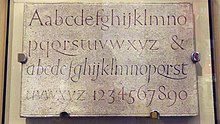Letterform

Letters carved byEric Gillfor a book,"Manuscript and Inscription Letters for Schools and Classes and for the Use of Craftsmen"(Edward Johnston 1909).[1]He later gave them to theVictoria and Albert Museumso they could be used by students at theRoyal College of Art.
Aletterform,letter-formorletter formis a term used especially intypography,palaeography,calligraphyandepigraphyto mean aletter'sshape. A letterform is a type ofglyph,which is a specific, concrete way of writing an abstractcharacterorgrapheme.
For example, medieval scholars may discuss the particular handwritten letterforms that distinguish one script from another.[2]
The history of letterforms is discussed in fields of study relating to materials used in writing.Epigraphyincludes the study of letterforms carved in stone or other permanent materials.Palaeographyis the study of writing in ancient and medieval manuscripts.Calligraphytreats the letterforms of decorative writing, usually in ink. In the field oftypography,type designis the process of designingtypefacesthat consist of sets of letterforms for use with metal print or computer. More broadly letterforms may be discussed wherever letters appear stylistically—ingraffitifor example.
In context
[edit]- Letterforms in Alpha bets:Arabic Alpha bet,Cyrillic script
- Letterforms in calligraphy:Man'yōgana,Hentaigana
- Letterforms in history:Long s,R rotunda
- Letterforms in technology:Typeface,Computer printer
See also
[edit]- Glyph– Purposeful written mark
- Grammatology– Study of graphemes and writing systems
- Graphemics– Study of graphemes and writing systems
- Sort (typesetting)– Block with a typographic character etched on it, which is lined up with others to print text
- Typeface anatomy– Graphic components of typeface letters
- Writing system– Convention of symbols representing language
References
[edit]- ^Edward Johnston (1909).Manuscript and Inscription Letters for Schools and Classes and for the Use of Craftsmen... With 5 plates by A.E.R. Gill.OCLC561934412.
- ^"Letterforms".Evolution of the Medieval Book.Rare and Manuscript Collections, Cornell University Library.
External links
[edit]- Letterforms in design:Is Gotham the New InterstateatThe Morning News
- Named parts of a letter:Type Anatomy 1.0
